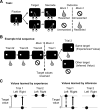A pallidus-habenula-dopamine pathway signals inferred stimulus values
- PMID: 20538770
- PMCID: PMC2934919
- DOI: 10.1152/jn.00158.2010
A pallidus-habenula-dopamine pathway signals inferred stimulus values
Abstract
The reward value of a stimulus can be learned through two distinct mechanisms: reinforcement learning through repeated stimulus-reward pairings and abstract inference based on knowledge of the task at hand. The reinforcement mechanism is often identified with midbrain dopamine neurons. Here we show that a neural pathway controlling the dopamine system does not rely exclusively on either stimulus-reward pairings or abstract inference but instead uses a combination of the two. We trained monkeys to perform a reward-biased saccade task in which the reward values of two saccade targets were related in a systematic manner. Animals used each trial's reward outcome to learn the values of both targets: the target that had been presented and whose reward outcome had been experienced (experienced value) and the target that had not been presented but whose value could be inferred from the reward statistics of the task (inferred value). We then recorded from three populations of reward-coding neurons: substantia nigra dopamine neurons; a major input to dopamine neurons, the lateral habenula; and neurons that project to the lateral habenula, located in the globus pallidus. All three populations encoded both experienced values and inferred values. In some animals, neurons encoded experienced values more strongly than inferred values, and the animals showed behavioral evidence of learning faster from experience than from inference. Our data indicate that the pallidus-habenula-dopamine pathway signals reward values estimated through both experience and inference.
Figures




References
-
- Camerer C, Ho T-H. Experience-weighted attraction learning in normal form games Econometrica 67: 827–874, 1999
-
- Daw ND, Courville AC, Touretzky DS. Representation and timing in theories of the dopamine system. Neural Comput 18: 1637–1677, 2006 - PubMed
-
- Daw ND, Niv Y, Dayan P. Uncertainty-based competition between prefrontal and dorsolateral striatal systems for behavioral control. Nat Neurosci 8: 1704–1711, 2005 - PubMed
Publication types
MeSH terms
Substances
Grants and funding
LinkOut - more resources
Full Text Sources

